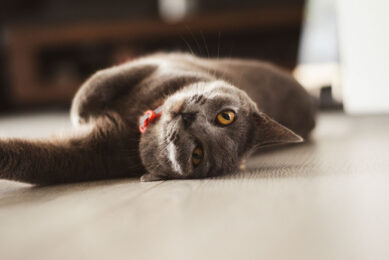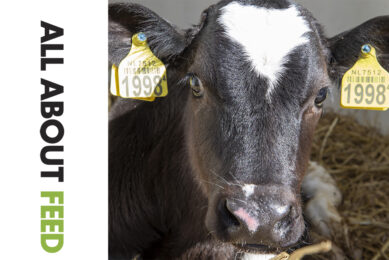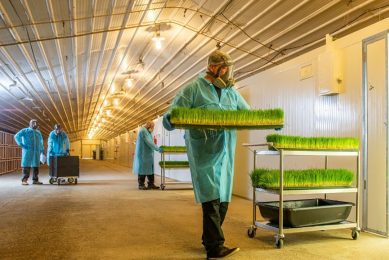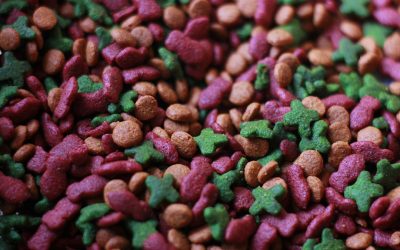Petfood palatability needs multi-factorial approach
Palatability is key in producing high quality petfood. This goes much further than choosing a palatability enhancer. It involves careful selection of ingredients and the right processing techniques.
Good animal feed – including pet food – starts with proper selection of high quality raw materials. Cheaper raw materials may sound appealing, but they may end up being more expensive as they may cause negative effects within the pet food that are difficult to overcome with further processing or flavour application. Major differences in palatability can be found in recipes based on vegetable raw materials (cereals), animal proteins (poultry meal) or fresh meat. For example, animal proteins such as poultry meal have poor functional properties for extrusion. It has less binding and water absorption capacity, which makes it more difficult in producing a good expanded kibble. Meat meals with a scorched or burned odour and taste will almost certainly cause rejection by cats and dogs and this is difficult to overcome. Analysis of only protein and ash level does not give you a good indication of these base characteristics. Proper process control at manufacturer’s level and control of colour and smell of incoming materials are therefore, of utmost importance to assure the quality. Good whole wheat gives less extruder problems and increased palatability. Wheat middling is cheaper than whole wheat and contains 16% protein versus 12% in whole wheat. However, wheat middling varies in density, which can lead to extruder surging, blowouts, more waste and down time. Another ingredients that can increase palatability is yeast. Adding yeast at 1 to 4% to a cat diet gives the optimum palatability effect. Also fish meal – used at 1-4% – will contribute to better tasting pet food.
Effect of extrusion
Extrusion is the main process of pet food production. Precondition and extrusion is a process which has an impact on different product properties e.g. cell structure, density and gelatinisation degree. Process parameters like retention time, temperature, pressure and moisture have an effect on these properties. The right amount of moisture in the pre-conditioner and extruder is important for a good gelatinisation of the starch (degree of cook). A higher gelatinisation gives an improved digestibility and palatability. By grinding the ingredients, the particles become smaller. This means that these particles can better absorb the moisture in the pre-conditioner. Good water absorption in turn results in a more expanded product, having a lower density. In general a lower density is more preferred by cats. A guideline for grinding is 1 mm, especially for cat food. The difference in appearance of the finished food with grinding on 1.5 mm is large. Sharp angles are not appreciated because it can hurt their sensitive palate. This could be a reason for a cat to refuse the food afterwards. To avoid this, it is important to have the die plate and knives of the extruder in good condition. For cat food the diameter of the kibble must be less than 1 cm. Cats must be able to move the kibble in their mouth before cracking it.
Extrusion is the main process of pet food production. Precondition and extrusion is a process which has an impact on different product properties e.g. cell structure, density and gelatinisation degree. Process parameters like retention time, temperature, pressure and moisture have an effect on these properties. The right amount of moisture in the pre-conditioner and extruder is important for a good gelatinisation of the starch (degree of cook). A higher gelatinisation gives an improved digestibility and palatability. By grinding the ingredients, the particles become smaller. This means that these particles can better absorb the moisture in the pre-conditioner. Good water absorption in turn results in a more expanded product, having a lower density. In general a lower density is more preferred by cats. A guideline for grinding is 1 mm, especially for cat food. The difference in appearance of the finished food with grinding on 1.5 mm is large. Sharp angles are not appreciated because it can hurt their sensitive palate. This could be a reason for a cat to refuse the food afterwards. To avoid this, it is important to have the die plate and knives of the extruder in good condition. For cat food the diameter of the kibble must be less than 1 cm. Cats must be able to move the kibble in their mouth before cracking it.
Uniform coating
The goal for dosing palatability enhancers is to achieve a uniform coating to meet the required palatability of the pet food. This will always be within a framework of cost efficiency. Looking at the cost per tonne of pet food, differences in dosage are usually of larger influence than the price/kg of the added product. For example: at a production of 20 tonnes/day a difference
of 0.1% in dosing will make a difference of €10,000- 15,000 on a yearly basis. For a well-coated pet food a combination of two factors is necessary:
The goal for dosing palatability enhancers is to achieve a uniform coating to meet the required palatability of the pet food. This will always be within a framework of cost efficiency. Looking at the cost per tonne of pet food, differences in dosage are usually of larger influence than the price/kg of the added product. For example: at a production of 20 tonnes/day a difference
of 0.1% in dosing will make a difference of €10,000- 15,000 on a yearly basis. For a well-coated pet food a combination of two factors is necessary:
1. Accurate dosing. This means that if you want to dose 10.0 kg/tonne, there is really 10.0 kg per tonne. An accurate weighing system assures this.
2. Equal distribution. Note that if on a batch of 1 tonne exactly 10 kg is applied, not necessarily every 100g (size of a meal) of the food will have the same level of palatant.
Different requirements
It is important to determine what the requirements are to evaluate dosing systems for palatability enhancers and fat. What is the capacity of the production, the quantity of coating to be applied, the process time, the desired accuracy and the possible combination with other coated products? There are many parameters to set such as droplet size, pressure, number of nozzles and injection time. In general, a closer definition of the application range (e.g. dosing level) will offer a more accurate system. For production of super premium pet food, a dosing system should offer room to play with different parameters. The presentation of pet food is important here and more features for the pet food will be desired. For example a vacuum coater can bring a certain fat for nutritional reasons inside the kibble. A second fat for shining can be added on the outside. Different systems can be chosen, having the abovementioned goal combined with the individual requirements. Every system has variations in its set-up, giving different performance. Which system is the best is based on individual requirements. Depending on these wishes, each system should be evaluated. With all systems, if designed and operated well, the desired coating
can be achieved. For each system there are advantages and disadvantages, the parameters to compare are given in Table 1. For every pet food producer, each parameter has its own importance.
It is important to determine what the requirements are to evaluate dosing systems for palatability enhancers and fat. What is the capacity of the production, the quantity of coating to be applied, the process time, the desired accuracy and the possible combination with other coated products? There are many parameters to set such as droplet size, pressure, number of nozzles and injection time. In general, a closer definition of the application range (e.g. dosing level) will offer a more accurate system. For production of super premium pet food, a dosing system should offer room to play with different parameters. The presentation of pet food is important here and more features for the pet food will be desired. For example a vacuum coater can bring a certain fat for nutritional reasons inside the kibble. A second fat for shining can be added on the outside. Different systems can be chosen, having the abovementioned goal combined with the individual requirements. Every system has variations in its set-up, giving different performance. Which system is the best is based on individual requirements. Depending on these wishes, each system should be evaluated. With all systems, if designed and operated well, the desired coating
can be achieved. For each system there are advantages and disadvantages, the parameters to compare are given in Table 1. For every pet food producer, each parameter has its own importance.
The right application
There are different ways to coat fat and palatability enhancers as mentioned in Table 1. Nozzles, which are used for spraying the liquid in the coater, should be checked regularly to be sure a good spray is achieved. When the coating is not uniform it can result in dark spots on the kibble (visual aspect). The choice of the right nozzle is important and this depends on the viscosity and quantity which need to be dosed. Flat spray nozzles or full cone are mostly used. Fat should be coated on the kibble before the palatability enhancer is coated. For powder palatability enhancers the fat acts like glue. When different kinds of fat/oil are applied it is recommended to apply first the most “sensitive” fat, e.g. salmon oil. This reduces the contact with air and prevents against oxidation. The impact of an uneven distribution is shown in the trial in Figure 1. A normal cat food with a 2% liquid coating was tested versus a cat food of mixed kibbles (50/50) with no and 4% coating. Total amount of coating per meal is equal in this test. It was concluded that the acceptance of both foods showed a difference of 2 to 1. Palatability was tested in a two bowl test where at the end of the trial the total amount which is eaten was measured as Intake Ratio. Fat and palatability enhancer both make a food palatable. The fat quality (ea peroxide value/rancidity) is important, even more important than the source of fat. An indication of good fat quality is determined by a Peroxide Value< 3 and FFA <1.5. Poultry fat would be the most preferable in terms of palatability.
There are different ways to coat fat and palatability enhancers as mentioned in Table 1. Nozzles, which are used for spraying the liquid in the coater, should be checked regularly to be sure a good spray is achieved. When the coating is not uniform it can result in dark spots on the kibble (visual aspect). The choice of the right nozzle is important and this depends on the viscosity and quantity which need to be dosed. Flat spray nozzles or full cone are mostly used. Fat should be coated on the kibble before the palatability enhancer is coated. For powder palatability enhancers the fat acts like glue. When different kinds of fat/oil are applied it is recommended to apply first the most “sensitive” fat, e.g. salmon oil. This reduces the contact with air and prevents against oxidation. The impact of an uneven distribution is shown in the trial in Figure 1. A normal cat food with a 2% liquid coating was tested versus a cat food of mixed kibbles (50/50) with no and 4% coating. Total amount of coating per meal is equal in this test. It was concluded that the acceptance of both foods showed a difference of 2 to 1. Palatability was tested in a two bowl test where at the end of the trial the total amount which is eaten was measured as Intake Ratio. Fat and palatability enhancer both make a food palatable. The fat quality (ea peroxide value/rancidity) is important, even more important than the source of fat. An indication of good fat quality is determined by a Peroxide Value< 3 and FFA <1.5. Poultry fat would be the most preferable in terms of palatability.
The total amount of fat depends on the food diet. A high level of fat in the extruded mix results in a dense product and a low level of expansion. A more expanded, open-structured kibble will absorb more topical coated fat. A smaller particle size results in a finer cell structure, it improves retention of liquid coatings. When a vacuum coater is used a higher level of fat application is possible. Liquid palatability enhancer is dosed in a range of 1-4%, powder will be dosed in a range of 0.5-2 %. At the highest levels of application a palatability plateau is reached. The choice of a palatability enhancer and the right dosage are always connected to reach the required palatability.
In general, the fat is coated on the pet food after the drying process. The temperature of the pet food after the dryer is approximately 50ºC – 60ºC. Warm kibbles are able to absorb more and quickly the fat. Also the fat needs to have the same temperature for good absorption.
For liquid pal enhancer environment temperature is recommended but for viscosity reason you could warm up the liquid till maximum of 40ºC. The order of coating of fat and palatability enhancer has an effect on the palatability. The left bar in Figure 2 shows the product which is coated first with the fat followed by the palatability enhancer.
For liquid pal enhancer environment temperature is recommended but for viscosity reason you could warm up the liquid till maximum of 40ºC. The order of coating of fat and palatability enhancer has an effect on the palatability. The left bar in Figure 2 shows the product which is coated first with the fat followed by the palatability enhancer.
The second bar shows the product which is first coated with the palatability enhancer and afterwards with the fat. If a combination of liquid and powder palatability enhancer is used, the recommended order is: fat – liquid powder.
Future developments
Looking at the pet food market, we see a trend towards more sophisticated pet foods. To make pet food more palatable is a challenge for product developers and process engineers. Especially in the super premium segment – a growing market – palatability is and will be a key factor to work on and improve.
Looking at the pet food market, we see a trend towards more sophisticated pet foods. To make pet food more palatable is a challenge for product developers and process engineers. Especially in the super premium segment – a growing market – palatability is and will be a key factor to work on and improve.
Please click on PDF below for a full view of the tables and figures.











